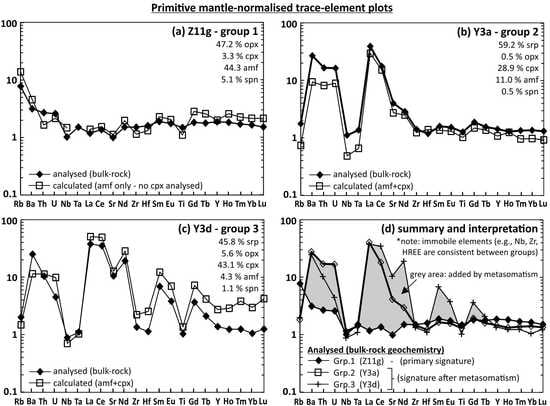Assessing the Validity of Negative High Field Strength-Element Anomalies as a Proxy for Archaean Subduction: Evidence from the Ben Strome Complex, NW Scotland
Abstract
1. Introduction
2. Regional Geology
2.1. The Mainland Lewisian Gneiss Complex
2.2. The Ben Strome Complex
3. Materials and Methods
3.1. Bulk-Rock Chemistry
3.2. Element Mapping
3.3. Major-Element Mineral Chemistry
3.4. Trace-Element Mineral Chemistry
4. Bulk-Rock Chemistry
4.1. Spatial Distribution of Samples
4.2. Major-Elements
4.3. Trace-Elements
5. Petrography
6. Mineral Chemistry
6.1. Orthopyroxene
6.2. Clinopyroxene
6.3. Amphibole
6.4. Carbonate Phases
7. Discussion
7.1. Constraining the Bulk-Rock Geochemical Controls
7.2. Origin of the High Field Strength Elements Anomalies
7.2.1. Primary Magmatic Processes
7.2.2. Crustal Contamination
7.2.3. Secondary Metasomatism
7.3. Implications for Geochemical Fingerprinting in Archaean Cratons
8. Conclusions
- Negative HFSE anomalies, which are commonly used as evidence for subduction-related magmatism in the Archaean, can also be generated by secondary processes that may be petrographically discrete. In the case of the Ben Strome Complex, these anomalies were most likely generated by LREE enrichment during metasomatism by a CO2 and H2O-rich hydrothermal fluid associated with amphibolitisation, rather than reflecting a signature inherited from a subduction-related magma.
- Our data demonstrate that the HFSE anomaly should be used (as a proxy for Archaean subduction) with extreme caution, particularly in Archaean terranes that have experienced multiple phases of high-grade metamorphism and where the rocks are likely to have experienced differential element mobilities. Consequently, conducting a comprehensive assessment of element mobility and petrography (using well characterised and spatially constrained samples) is a minimum requirement prior to assigning any geodynamic interpretation to Archaean ultramafic-mafic units. In cases where such assessments have not been undertaken, it is possible that subduction-related interpretations have been erroneously invoked, with the role of subduction as an Archaean geodynamic process potentially overestimated as a result.
Supplementary Materials
Author Contributions
Funding
Acknowledgments
Conflicts of Interest
References
- Pearce, J.A.; Cann, J.R. Tectonic setting of basic volcanic rocks determined using trace element analyses. Earth Planet. Sci. Lett. 1973, 19, 290–300. [Google Scholar] [CrossRef]
- Condie, K.C. TTGs and adakites: Are they both slab melts? Lithos 2005, 80, 33–44. [Google Scholar] [CrossRef]
- Pearce, J.A. Geochemical fingerprinting of oceanic basalts with applications to ophiolite classification and the search for Archean oceanic crust. Lithos 2008, 100, 14–48. [Google Scholar] [CrossRef]
- Klemme, S.; Prowatke, S.; Hametner, K.; Gunther, D. Partitioning of trace elements between rutile and silicate melts: Implications for subduction zones. Geochim. Cosmochim. Acta 2005, 69, 2361–2371. [Google Scholar] [CrossRef]
- Arndt, N. Why was flood volcanism on submerged continental platforms so common in the Precambrian? Precambrian Res. 1999, 97, 155–164. [Google Scholar] [CrossRef]
- Pearce, J.A. Geochemical Fingerprinting of the Earth’s Oldest Rocks. Geology 2014, 42, 175–176. [Google Scholar] [CrossRef]
- Wood, S.A. The aqueous geochemistry of the rare-earth elements and yttrium. Chem. Geol. 1990, 82, 159–186. [Google Scholar] [CrossRef]
- Lee, J.H.; Byrne, R.H. Complexation of trivalent rare earth elements (Ce, Eu, Gd, Tb, Yb) by carbonate ions. Geochemica Cosmochim. Acta 1993, 57, 295–302. [Google Scholar]
- Rudnick, R.L.; Mcdonough, W.F.; Chappell, B.W. Carbonatite metasomatism in the northern Tanzanian mantle: petrographic and geochemical characteristics. Earth Planet. Sci. Lett. 1993, 114, 463–475. [Google Scholar] [CrossRef]
- Lahaye, Y.; Arndt, N.; Byerly, G.; Chauvel, C.; Fourcade, S.; Gruau, G. The influence of alteration on the trace-element and Nd isotopic compositions of komatiites. Chem. Geol. 1995, 126, 43–64. [Google Scholar] [CrossRef]
- Smith, M.P.; Henderson, P.; Campbell, L.S. Fractionation of the REE during hydrothermal processes: Constraints from the Bayan Obo Fe-REE-Nb deposit, Inner Mongolia, China. Geochim. Cosmochim. Acta 2000, 64, 3141–3160. [Google Scholar] [CrossRef]
- Rolland, Y.; Cox, S.; Boullier, A.; Pennacchioni, G.; Mancktelow, N. Rare earth and trace element mobility in mid-crustal shear zones: Insights from the Mont Blanc Massif (Western Alps). Earth Planet. Sci. Lett. 2003, 214, 203–219. [Google Scholar] [CrossRef]
- Powell, W.; Zhang, M.; Reilly, S.Y.O.; Tiepolo, M. Mantle amphibole trace-element and isotopic signatures trace multiple metasomatic episodes in lithospheric mantle, western Victoria, Australia. Lithos 2004, 75, 141–171. [Google Scholar] [CrossRef]
- Metrich, N.; Bertagnini, A.; Landi, P.; Rosi, M. Crystallization Driven by Decompression and Water Loss at Stromboli Volcano (Aeolian Islands, Italy). J. Petrol. 2001, 42, 1471–1490. [Google Scholar] [CrossRef]
- Metrich, N.; Bertagnini, A.; Landi, P.; Rosi, M.; Belhadj, O. Triggering mechanism at the origin of paroxysms at Stromboli (Aeolian Archipelago, Italy): The 5 April 2003 eruption. Geophys. Res. Lett. 2005, 32, 3–6. [Google Scholar] [CrossRef]
- Landi, P.; Francalanci, L.; Pompilio, M.; Rosi, M.; Corsaro, R.A. The December 2002–July 2003 effusive event at Stromboli volcano, Italy: Insights into the shallow plumbing system by petrochemical studies. J. Volcanol. Geotherm. Res. 2006, 155, 263–284. [Google Scholar] [CrossRef]
- Corazzato, C.; Francalanci, L.; Menna, M.; Petrone, C.M.; Renzulli, A. What controls sheet intrusion in volcanoes? Structure and petrology of the Stromboli sheet complex, Italy. J. Volcanol. Geotherm. Res. 2008, 173, 26–54. [Google Scholar] [CrossRef]
- Renzulli, A.; Del Moro, S.; Menna, M.; Landi, P.; Piermattei, M. Transient processes in Stromboli’s shallow basaltic system inferred from dolerite and magmatic breccia blocks erupted during the 5 April 2003 paroxysm. Bull. Volcanol. 2009, 71, 795–813. [Google Scholar] [CrossRef]
- Vezzoli, L.; Renzulli, A.; Menna, M. Growth after collapse: The volcanic and magmatic history of the Neostromboli lava cone (island of Stromboli, Italy). Bull. Volcanol. 2014, 76, 24. [Google Scholar] [CrossRef]
- Manya, S. Geochemistry and petrogenesis of volcanic rocks of the Neoarchaean Sukumaland Greenstone Belt, northwestern Tanzania. J. Afr. Earth Sci. 2004, 40, 269–279. [Google Scholar] [CrossRef]
- Ordóñez-Calderón, J.C.; Polat, A.; Fryer, B.J.; Appel, P.W.U.; Van Gool, J.A.M.; Dilek, Y.; Gagnon, J.E. Geochemistry and geodynamic origin of the Mesoarchean Ujarassuit and Ivisaartoq greenstone belts, SW Greenland. Lithos 2009, 113, 133–157. [Google Scholar] [CrossRef]
- Manikyamba, C.; Kerrich, R. Geochemistry of alkaline basalts and associated high-Mg basalts from the 2.7 Ga Penakacherla Terrane, Dharwar craton, India: An Archean depleted mantle-OIB array. Precambrian Res. 2011, 188, 104–122. [Google Scholar] [CrossRef]
- Yellappa, T.; Santosh, M.; Chetty, T.R.K.; Kwon, S.; Park, C.; Nagesh, P.; Mohanty, D.P.; Venkatasivappa, V. A Neoarchean dismembered ophiolite complex from southern India: Geochemical and geochronological constraints on its suprasubduction origin. Gondwana Res. 2012, 21, 246–265. [Google Scholar] [CrossRef]
- Yellappa, T.; Venkatasivappa, V.; Koizumi, T.; Chetty, T.R.K.; Santosh, M.; Tsunogae, T. Journal of Asian Earth Sciences The mafic-ultramafic complex of Aniyapuram, Cauvery Suture Zone, southern India: Petrological and geochemical constraints for Neoarchean suprasubduction zone tectonics. J. Asian Earth Sci. 2014, 95, 81–98. [Google Scholar] [CrossRef]
- Szilas, K.; Van Hinsberg, V.J.; Kisters, A.F.M.; Hoffmann, J.E.; Windley, B.F.; Kokfelt, T.F.; Scherstén, A.; Frei, R.; Rosing, M.T.; Münker, C. Remnants of arc-related Mesoarchaean oceanic crust in the Tartoq Group of SW Greenland. Gondwana Res. 2013, 23, 436–451. [Google Scholar] [CrossRef]
- Wang, D.; Guo, J.; Huang, G.; Scheltens, M. The Neoarchean ultramafic-mafic complex in the Yinshan Block, North China Craton: Magmatic monitor of development of Archean lithospheric mantle. Precambrian Res. 2015, 270, 80–99. [Google Scholar] [CrossRef]
- Guo, R.; Liu, S.; Bai, X.; Wang, W. A Neoarchean subduction recorded by the Eastern Hebei Precambrian basement, North China Craton: Geochemical fingerprints from metavolcanic rocks of the Saheqiao-Shangying-Qinglong supracrustal belt. J. Asian Earth Sci. 2017, 135, 347–369. [Google Scholar] [CrossRef]
- Stern, R.J. Evidence from ophiolites, blueschists, and ultrahigh-pressure metamorphic terranes that the modern episode of subduction tectonics began in Neoproterozoic. Geology 2005, 33, 557–560. [Google Scholar] [CrossRef]
- Stern, R.J. Modern-style plate tectonics began in Neoproterozoic time: An alternative interpretation of Earth’s tectonic history. Spec. Publ. Geol. Soc. Am. 2008, 440, 265–280. [Google Scholar]
- Kearey, P.; Klepeis, K.A.; Vine, F.J. Global Tectonics, 3rd ed.; Wiley-Blackwell: Hoboken, NJ, USA, 2009. [Google Scholar]
- Arndt, N.T. Formation and Evolution of the Continental Crust. Geochem. Perspect. 2013, 2, 405–533. [Google Scholar] [CrossRef]
- Bédard, J.H.; Harris, L.B.; Thurston, P.C. The hunting of the snArc. Precambrian Res. 2013, 229, 20–48. [Google Scholar] [CrossRef]
- Kamber, B.S. The evolving nature of terrestrial crust from the Hadean, through the Archaean, into the Proterozoic. Precambrian Res. 2015, 258, 48–82. [Google Scholar] [CrossRef]
- De Wit, M.J.; De Ronde, C.E.J.; Tredoux, M.; Roering, C.; Hart, R.J.; Armstrong, R.A.; Green, R.W.E.; Peberdy, E.; Hart, R.A. Formation of an Archaean continent. Nature 1992, 357, 553–562. [Google Scholar] [CrossRef]
- Friend, C.R.L.; Nutman, A.P.; The, A.; Isua, E. Eoarchean ophiolites? New evidence for the debate on the Isua supracrustal belt, southern west Greenland. Am. J. Sci. 2010, 310, 826–861. [Google Scholar] [CrossRef]
- Furnes, H.; Dilek, Y.; de Wit, M. Precambrian greenstone sequences represent different ophiolite types. Gondwana Res. 2015, 27, 649–685. [Google Scholar] [CrossRef]
- Hastie, A.R.; Fitton, J.G.; Bromiley, G.D.; Butler, I.B.; Odling, N.W.A. The origin of Earth’s first continents and the onset of plate tectonics. Geology 2016, 855–858. [Google Scholar] [CrossRef]
- Polat, A.; Kokfelt, T.; Burke, K.C.; Kusky, T.M.; Bradley, D.C.; Dziggel, A.; Kolb, J.; William, P.; Polat, A.; Kokfelt, T.; et al. Lithological, structural, and geochemical characteristics of Mesoarchean Târtoq greenstone belt, southern West Greenland, and the Chugach-Prince William accretionary complex, southern Alaska: evidence for uniformitarian plate-tectonic processes. Can. J. Earth Sci. 2016, 53, 1336–1371. [Google Scholar] [CrossRef]
- Johnson, T.E.; Brown, M.; Gardiner, N.J.; Kirkland, C.L.; Smithies, R.H. Earth’s first stable continents did not form by subduction. Nature 2017, 543, 239–242. [Google Scholar] [CrossRef] [PubMed]
- Bédard, J.H. Stagnant lids and mantle overturns: Implications for Archaean tectonics, magmagenesis, crustal growth, mantle evolution, and the start of plate tectonics. Geosci. Front. 2018, 9, 19–49. [Google Scholar] [CrossRef]
- Van Kranendonk, M.J.; Collins, W.J.; Hickman, A.; Pawley, M.J. Critical tests of vertical vs. horizontal tectonic models for the Archaean East Pilbara Granite-Greenstone Terrane, Pilbara Craton, Western Australia. Precambrian Res. 2004, 131, 173–211. [Google Scholar] [CrossRef]
- Dhuime, B.; Wuestefeld, A.; Hawkesworth, C.J. Emergence of modern continental crust about 3 billion years ago. Nat. Geosci. 2015, 8, 552–555. [Google Scholar] [CrossRef]
- Hopkins, M.; Harrison, T.M.; Manning, C.E. Low heat flow inferred from >4 Gyr zircons suggests Hadean plate boundary interactions. Nature 2008, 456, 493–496. [Google Scholar] [CrossRef] [PubMed]
- Hamilton, W.B. Plate tectonics began in Neoproterozoic time, and plumes from deep mantle have never operated. Lithos 2011, 123, 1–20. [Google Scholar] [CrossRef]
- Guice, G.L.; McDonald, I.; Hughes, H.S.R.; MacDonald, J.M.; Blenkinsop, T.G.; Goodenough, K.M.; Faithfull, J.W.; Gooday, R.J. Re-evaluating ambiguous age relationships in Archean cratons: Implications for the origin of ultramafic-mafic complexes in the Lewisian Gneiss Complex. Precambrian Res. 2018, 311, 136–156. [Google Scholar] [CrossRef]
- Johnson, T.E.; Fischer, S.; White, R.W.; Brown, M.; Rollinson, H.R. Archaean intracrustal differentiation from partial melting of metagabbro-field and geochemical evidence from the central region of the Lewisian complex, NW Scotland. J. Petrol. 2012, 53, 2115–2138. [Google Scholar] [CrossRef]
- Johnson, T.E.; Fischer, S.; White, R.W. Field and petrographic evidence for partial melting of TTG gneisses from the central region of the mainland Lewisian complex, NW Scotland. J. Geol. Soc. Lond. 2013, 170, 319–326. [Google Scholar] [CrossRef]
- Park, R.G.; Stewart, A.D.; Wright, A.E. The Hebridean Terrane. In The Geology of Scotland; Trewin, N.H., Ed.; Geological Society of London: London, UK, 2002. [Google Scholar]
- Peach, B.N.; Horne, J.; Gunn, A.G.; Clough, C.T.; Geikie, A.; Hinxman, L.W.; Teall, J.J.H. The Geological Structure of the North-West Highlands. In Memoir of the Geological Survey of Great Britain; HMSO: Edimburgh, UK, 1907. [Google Scholar]
- Sutton, J.; Watson, J.V. The pre-Torridonian metamorphic history of the Loch Torridon and Scourie areas in the northwest Highland, and its bearing on the chronological classification of the Lewisian. Q. J. Geol. Soc. 1951, 106, 241–307. [Google Scholar] [CrossRef]
- Wheeler, J.; Park, R.G.; Rollinson, H.R.; Beach, A. The Lewisian Complex: insights into deep crustal evolution. Geol. Soc. Lond., Spec. Publ. 2010, 335, 51–79. [Google Scholar] [CrossRef]
- Sheraton, J.W.; Skinner, A.C.; Tarney, J. The geochemistry of the Scourian gneisses of the Assynt district. In The Early Precambrian Rocks of Scotland and Related Rocks of Greenland; University of Keele: Keele, UK, 1973; pp. 13–30. [Google Scholar]
- Park, R.G.; Tarney, J. The Lewisian complex: a typical Precambrian high-grade terrain? Geol. Soc. London, Spec. Publ. 1987, 27, 13–25. [Google Scholar] [CrossRef]
- Kinny, P.; Friend, C.; Love, G. Proposal for a terrane-based nomenclature for the Lewisian Gneiss Complex of NW Scotland. J. Geol. Soc. Lond. 2005, 162, 175–186. [Google Scholar] [CrossRef]
- Love, G.J.; Friend, C.R.L.; Kinny, P.D. Palaeoproterozoic terrane assembly in the Lewisian Gneiss Complex on the Scottish mainland, south of Gruinard Bay: SHRIMP U-Pb zircon evidence. Precambrian Res. 2010, 183, 89–111. [Google Scholar] [CrossRef]
- Kinny, P.D.; Friend, C.R.L. U-Pb isotopic evidence for the accretion of different crustal blocks to form the Lewisian Complex of northwest Scotland. Contrib. Mineral. Petrol. 1997, 129, 326–340. [Google Scholar] [CrossRef]
- Friend, C.R.L.; Kinny, P.D. A reappraisal of the Lewisian Gneiss Complex: geochronological evidence for its tectonic assembly from disparate terranes in the Proterozoic. Contrib. Mineral. Petrol. 2001, 142, 198–218. [Google Scholar] [CrossRef]
- Love, G.J.; Kinny, P.D.; Friend, C.R.L. Timing of magmatism and metamorphism in the Gruinard Bay area of the Lewisian Gneiss Complex: Comparisons with the Assynt Terrane and implications for terrane accretion. Contrib. Mineral. Petrol. 2004, 146, 620–636. [Google Scholar] [CrossRef]
- Park, R.G. The Lewisian terrane model: a review. Scott. J. Geol. 2005, 41, 105–118. [Google Scholar] [CrossRef]
- Goodenough, K.M.; Park, R.G.; Krabbendam, M.; Myers, J.S.; Wheeler, J.; Loughlin, S.C.; Crowley, Q.G.; Friend, C.R.L.; Beach, A.; Kinny, P.D.; Graham, R.H. The Laxford Shear Zone: An end-Archaean terrane boundary? Geol. Soc. Lond., Spec. Publ. 2010, 335, 103–120. [Google Scholar] [CrossRef]
- Goodenough, K.M.; Crowley, Q.G.; Krabbendam, M.; Parry, S.F. New U-Pb age constraints for the Laxford Shear Zone, NW Scotland: Evidence fortectono-magmatic processes associated with the formation of a Paleoproterozoic supercontinent. Precambrian Res. 2013, 232, 1–19. [Google Scholar] [CrossRef]
- Crowley, Q.G.; Key, R.; Noble, S.R. High-precision U–Pb dating of complex zircon from the Lewisian Gneiss Complex of Scotland using an incremental CA-ID-TIMS approach. Gondwana Res. 2015, 27, 1381–1391. [Google Scholar] [CrossRef]
- MacDonald, J.M.; Goodenough, K.M.; Wheeler, J.; Crowley, Q.; Harley, S.L.; Mariani, E.; Tatham, D. Temperature-time evolution of the Assynt Terrane of the Lewisian Gneiss Complex of Northwest Scotland from zircon U-Pb dating and Ti thermometry. Precambrian Res. 2015, 260, 55–75. [Google Scholar] [CrossRef]
- Barooah, B.C.; Bowes, D.R. Multi-episodic modification of high-grade terrane near Scourie and its significance in elucidating the history of the Lewisian Complex. Scott. J. Geol. 2009, 45, 19–41. [Google Scholar] [CrossRef]
- Corfu, F. U-Pb zircon systematics at Gruinard Bay, northwest Scotland: Implications for the early orogenic evolution of the Lewisian complex. Contrib. Mineral. Petrol. 1998, 133, 329–345. [Google Scholar] [CrossRef]
- Feisel, Y.; White, R.W.; Palin, R.M.; Johnson, T.E. New constraints on granulite facies metamorphism and melt production in the Lewisian Complex, northwest Scotland. J. Metamorph. Geol. 2018, 36, 799–819. [Google Scholar] [CrossRef]
- Andersen, T.; Whitehouse, M.J.; Burke, E.A.J. Fluid inclusions in Scourian granulites from the Lewisian complex of NW Scotland: Evidence for CO2-rich fluid in Late Archaean high-grade metamorphism. Lithos 1997, 40, 93–104. [Google Scholar] [CrossRef]
- Park, R.G. The structural history of the Lewisian rocks of Gairloch, Wester Ross, Scotland. Q. J. Geol. Soc. 1964, 120, 397–426. [Google Scholar] [CrossRef]
- Beach, A. The mineralogy of high temperature shear zones at Scourie, N.W. Scotland. J. Petrol. 1973, 14, 231–248. [Google Scholar] [CrossRef]
- Attfield, P. The structural history of the Canisp Shear Zone. Geol. Soc. Lond. Spec. Publ. 1987, 27, 165–173. [Google Scholar] [CrossRef]
- Corfu, F.; Heaman, L.M.; Rogers, G. Polymetamorphic evolution of the Lewisian complex, NW Scotland, as recorded by U-Pb isotopic compositions of zircon, titanite and rutile. Contrib. Mineral. Petrol. 1994, 117, 215–228. [Google Scholar] [CrossRef]
- Davies, J.H.F.L.; Heaman, L.M. New U-Pb baddeleyite and zircon ages for the Scourie dyke swarm: A long-lived large igneous province with implications for the Paleoproterozoic evolution of NW Scotland. Precambrian Res. 2014, 249, 180–198. [Google Scholar] [CrossRef]
- Heaman, L.M.; Tarney, J. U–Pb Baddeleyite ages for the Scourie Dyke Swarm, Scotland—Evidence for 2 distinct intrusion events. Nature 1989, 340, 705–708. [Google Scholar] [CrossRef]
- Teall, J.J.H. The Metamorphosis of Dolerite into Hornblende-Schist. Q. J. Geol. Soc. 1885, 41. [Google Scholar] [CrossRef]
- Beach, A.; Coward, M.P.; Graham, R.H. An interpretation of the structural evolution of the Laxford Front, north-west Scotland. Scott. J. Geol. 1974, 9, 297–308. [Google Scholar] [CrossRef]
- Johnson, T.E.; Brown, M.; Goodenough, K.M.; Clark, C.; Kinny, P.D.; White, R.W. Subduction or sagduction? Ambiguity in constraining the origin of ultramafic-mafic bodies in the Archean crust of NW Scotland. Precambrian Res. 2016, 283, 89–105. [Google Scholar] [CrossRef]
- O’Hara, M.J. Zoned ultrabasic and basic gneiss masses in the early lewisian metamorphic complex at scourie, Sutherland. J. Petrol. 1961, 2, 248–276. [Google Scholar] [CrossRef]
- Bowes, D.R.; Park, R.G.; Wright, A.E. Layered intrusive rocks in the Lewisian of the North-West Highlands of Scotland. Q. J. Geol. Soc. 1964, 120, 153. [Google Scholar] [CrossRef]
- Sills, J.D. Geochemical Studies of the Lewisian Complex of the Western Assynt Region, NW Scotland. Ph.D. Thesis, University of Leicester, Leicester, UK, January 1981. [Google Scholar]
- Sills, J.D.; Savage, D.; Watson, J.V.; Windley, B.F. Layered ultramafic-gabbro bodies in the Lewisian of northwest Scotland: Geochemistry and petrogenesis. Earth Planet. Sci. Lett. 1982, 58, 345–360. [Google Scholar] [CrossRef]
- Rollinson, H.; Gravestock, P. The trace element geochemistry of clinopyroxenes from pyroxenites in the Lewisian of NW Scotland: Insights into light rare earth element mobility during granulite facies metamorphism. Contrib. Mineral. Petrol. 2012, 163, 319–335. [Google Scholar] [CrossRef]
- McDonald, I.; Viljoen, K.S. Platinum-group element geochemistry of mantle eclogites: a reconnaissance study of xenoliths from the Orapa kimberlite, Botswana. Appl. Earth Sci. 2006, 115, 81–93. [Google Scholar] [CrossRef]
- Babechuk, M.G.; Kamber, B.S.; Greig, A.; Canil, D.; Kodolányi, J. The behaviour of tungsten during mantle melting revisited with implications for planetary differentiation time scales. Geochim. Cosmochim. Acta 2010, 74, 1448–1470. [Google Scholar] [CrossRef]
- Govindaraju, K. Compilation of working values and samples description for 383 geostandards. Geostand. Newsl. 1994, 18, 1–158. [Google Scholar] [CrossRef]
- Ottley, C.J.; Pearson, D.G.; Irvine, G.J. A routine method for the dissolution of geological samples for the analysis of REE and trace elements via ICP-MS. In Plasma Source Mass Spectrometry: Applications and Emerging Technologies; Holland, G., Tanner, S.D., Eds.; The Royal Society of Chemistry: Cambridge, UK, 2003; pp. 221–230. [Google Scholar]
- Droop, G.T.R. A General Equation for Estimating Fe3+ Concentrations in Ferromagnesian Silicates and Oxides from Microprobe Analyses, Using Stoichiometric Criteria. Mineral. Mag. 1987, 51, 431–435. [Google Scholar] [CrossRef]
- Hughes, H.S.R.; McDonald, I.; Faithfull, J.W.; Upton, B.G.J.; Downes, H. Trace-element abundances in the shallow lithospheric mantle of the North Atlantic Craton margin: Implications for melting and metasomatism beneath Northern Scotland. Mineral. Mag. 2015, 79, 877–907. [Google Scholar] [CrossRef]
- McDonough, W.F.; Sun, S.S. The composition of the Earth. Chem. Geol. 1995, 120, 223–253. [Google Scholar] [CrossRef]
- Sun, S.S.; McDonough, W.F. Chemical and isotopic systematics of oceanic basalts: implications for mantle composition and processes. Geol. Soc. Lond. Spec. Publ. 1989, 42, 313–345. [Google Scholar] [CrossRef]
- Rollinson, H. Geochemical constraints on the composition of Archaean lower continental crust: Partial melting in the Lewisian granulites. Earth Planet. Sci. Lett. 2012, 351–352, 1–12. [Google Scholar] [CrossRef]
- Williams-Jones, A.E.; Migdisov, A.A.; Samson, I.M. of the Rare Earth Elements—a Tale of “Ceria” and “Yttria”. Elements 2012, 8, 355–360. [Google Scholar] [CrossRef]
- Beach, A.; Tarney, J. Major and trace element patterns established during retrogressive metamorphism of granulite-facies gneisses, NW Scotland. Precambrian Res. 1978, 7, 325–348. [Google Scholar] [CrossRef]
- Yaxley, G.M.; Crawford, A.J.; Green, D.H. Evidence for carbonatite metasomatism in spinel peridotite xenoliths from western Victoria, Australia. Earth Planet. Sci. Lett. 1991, 107, 305–317. [Google Scholar] [CrossRef]
- Yaxley, G.M.; Green, D.H.; Kamenetsky, V. Carbonatite Metasomatism in the Southeastern Australian Lithosphere. J. Petrol. 1998, 39, 1917–1930. [Google Scholar] [CrossRef]
- Babechuk, M.G.; Kamber, B.S. An estimate of 1.9 Ga mantle depletion using the high-field-strength elements and Nd-Pb isotopes of ocean floor basalts, Flin Flon Belt, Canada. Precambrian Res. 2011, 189, 114–139. [Google Scholar] [CrossRef]
- Collerson, K.D.; Kamber, B.S. Evolution of the continents and the atmosphere inferred from Th-U-Nb systematics of the depleted mantle. Science 1999, 283, 1519–1522. [Google Scholar] [CrossRef] [PubMed]
- Condie, K.C. Incompatible element ratios in oceanic basalts and komatiites: Tracking deep mantle sources and continental growth rates with time. Geochem. Geophy. Geosyst. 2003, 4, 1–28. [Google Scholar] [CrossRef]
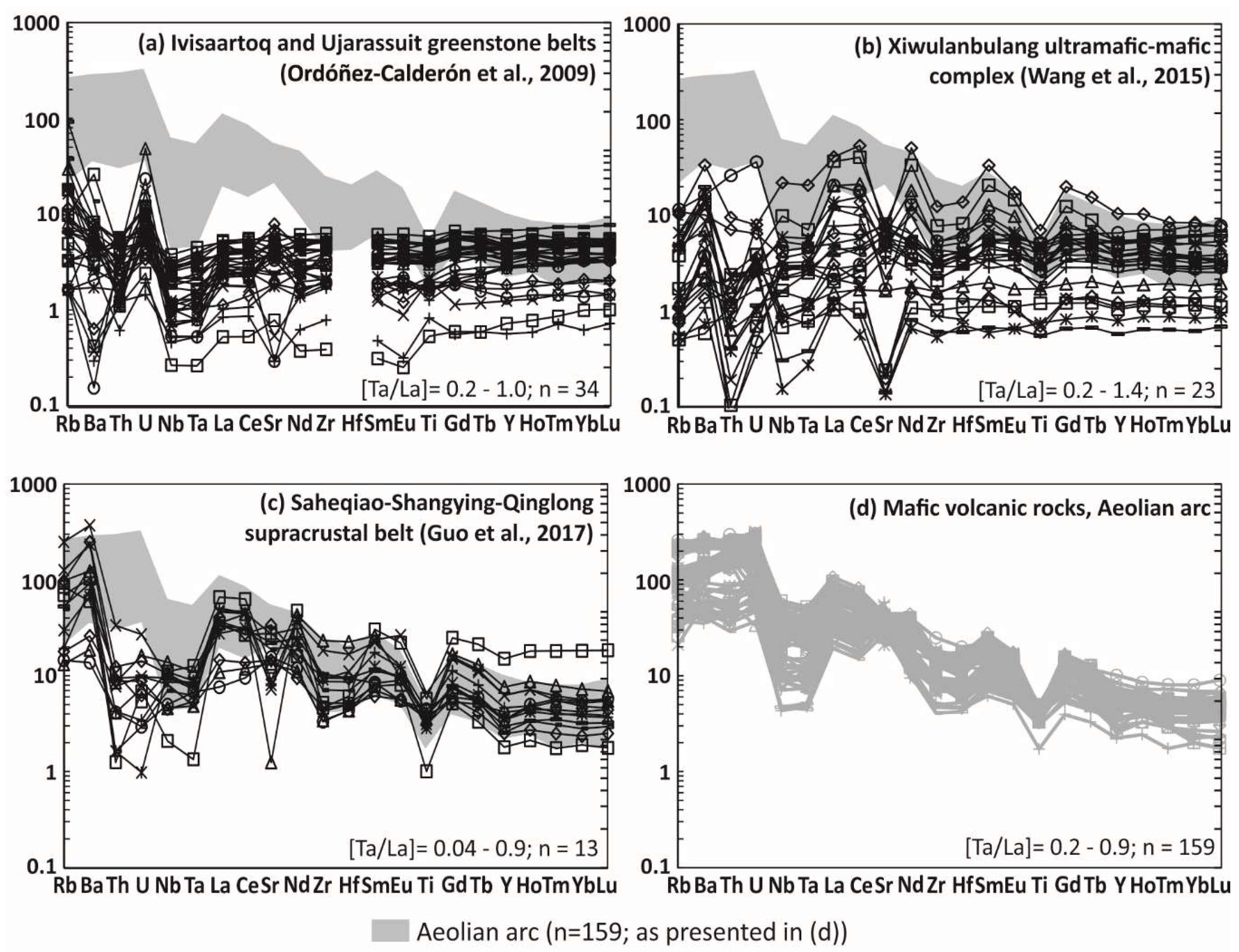
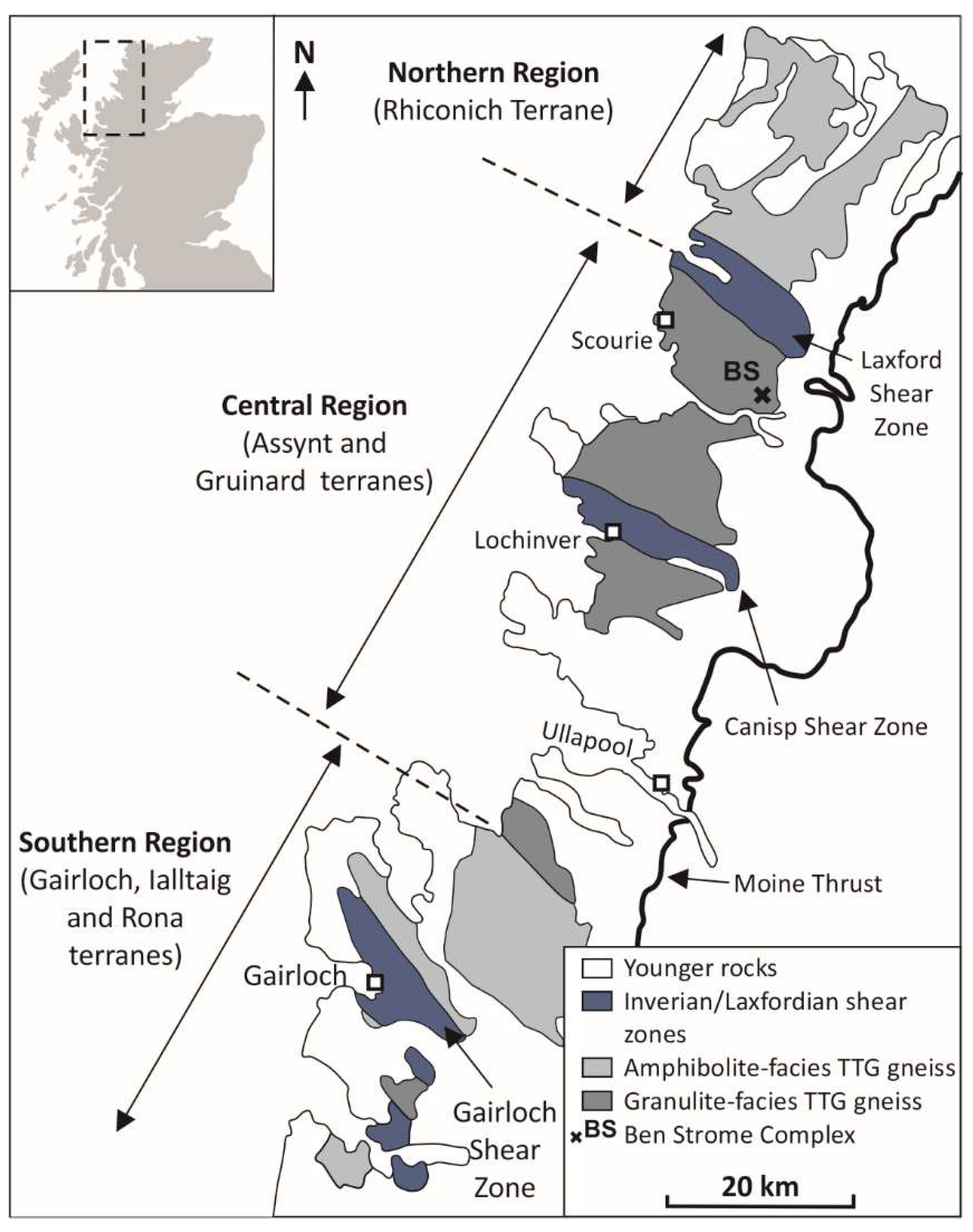
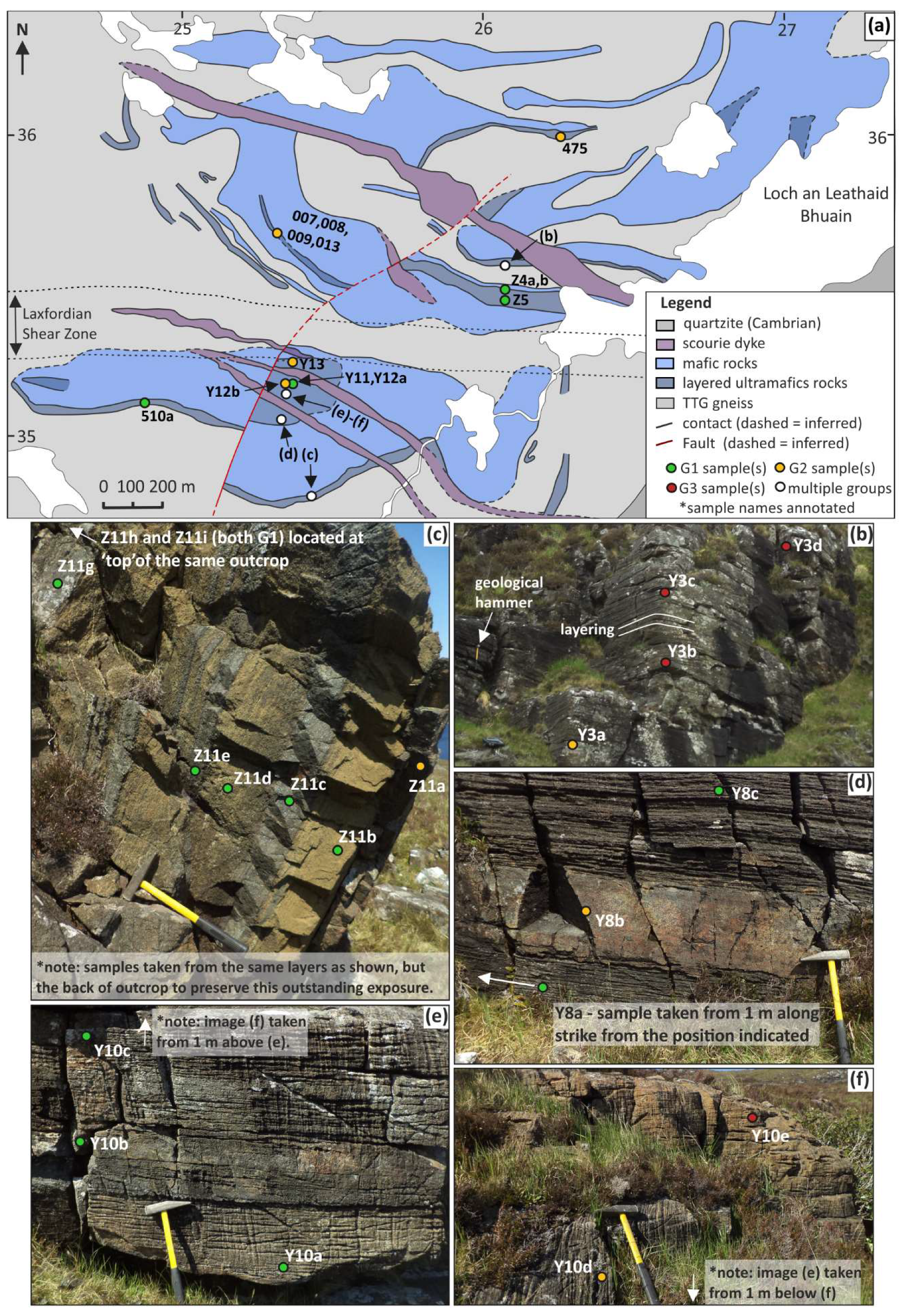
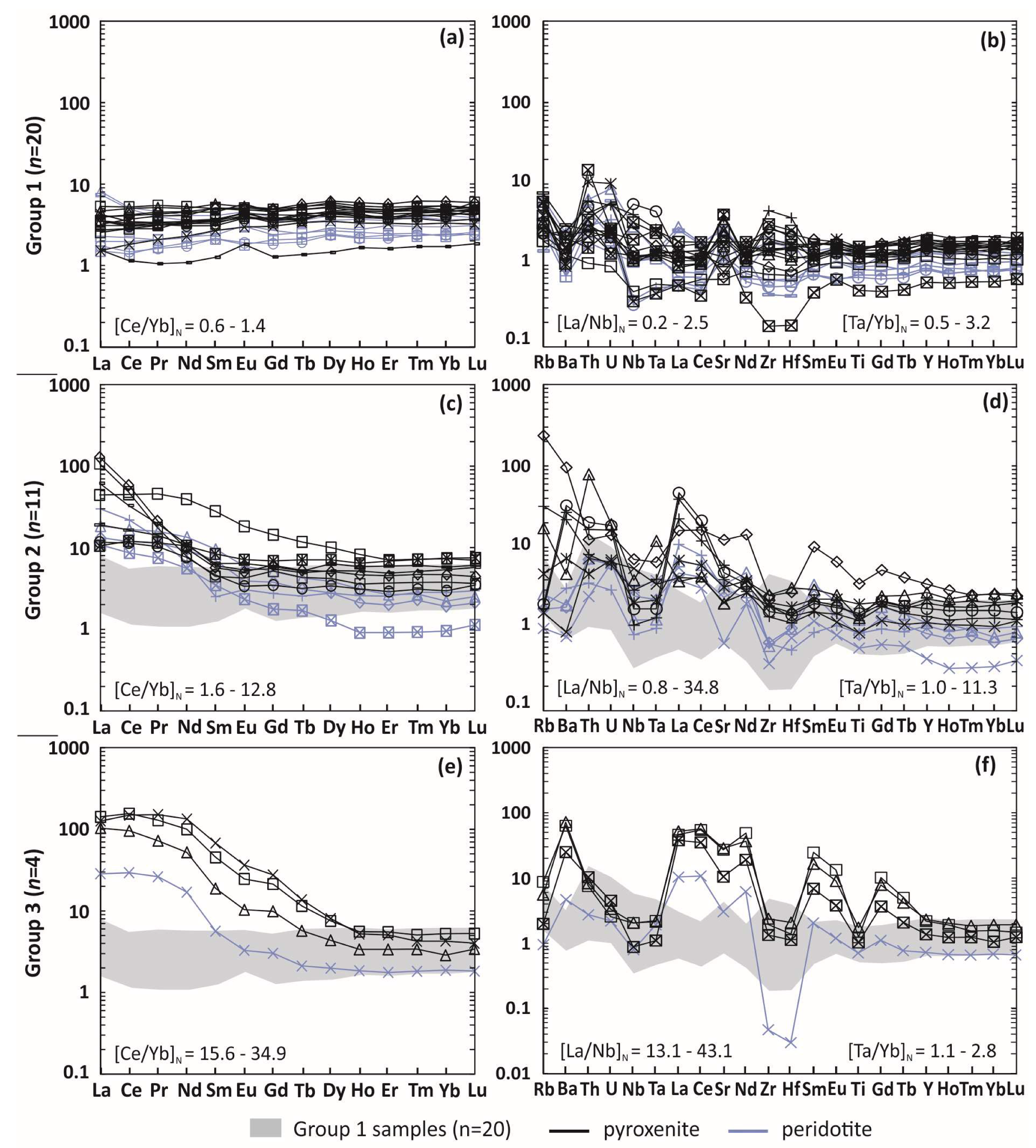
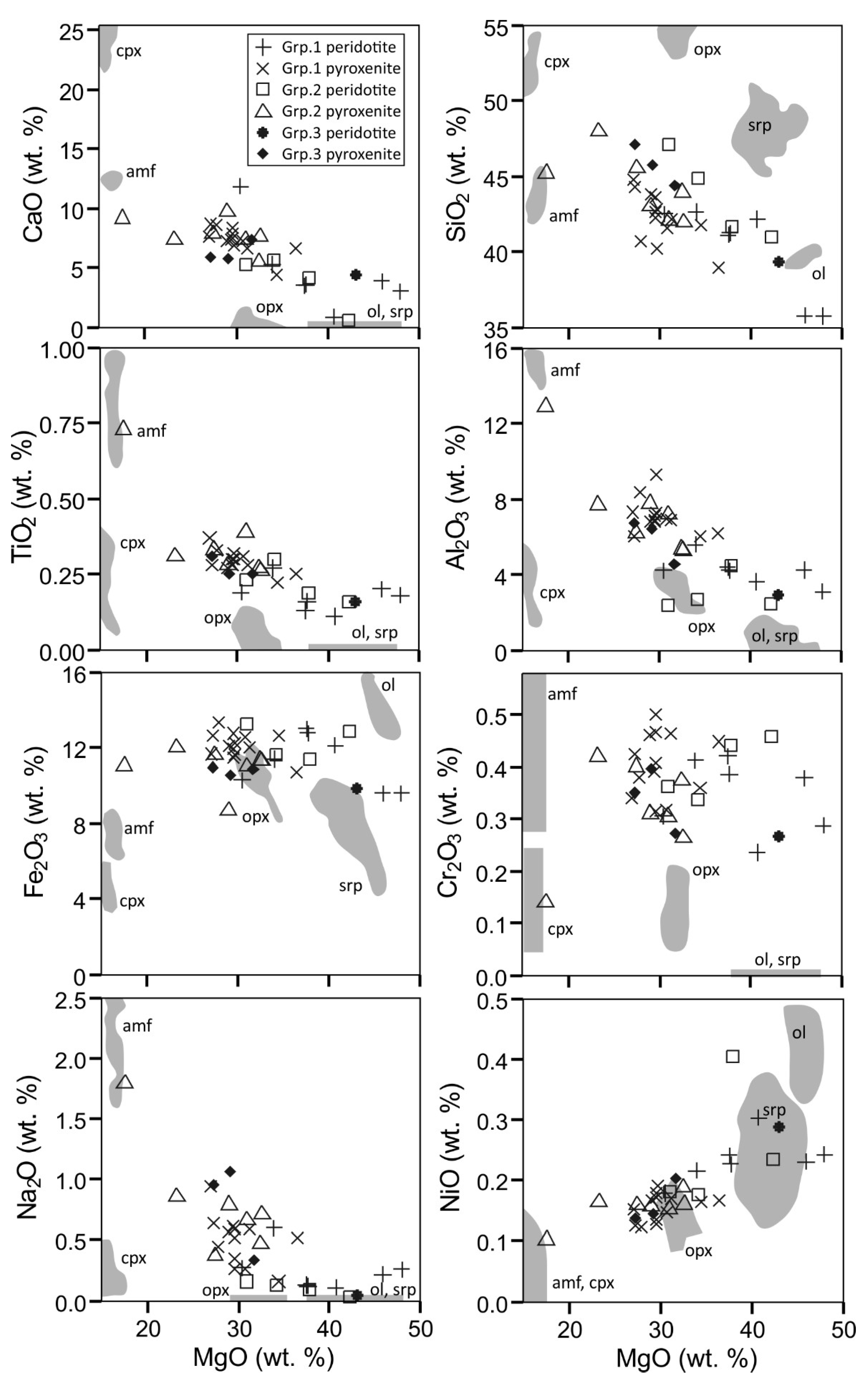

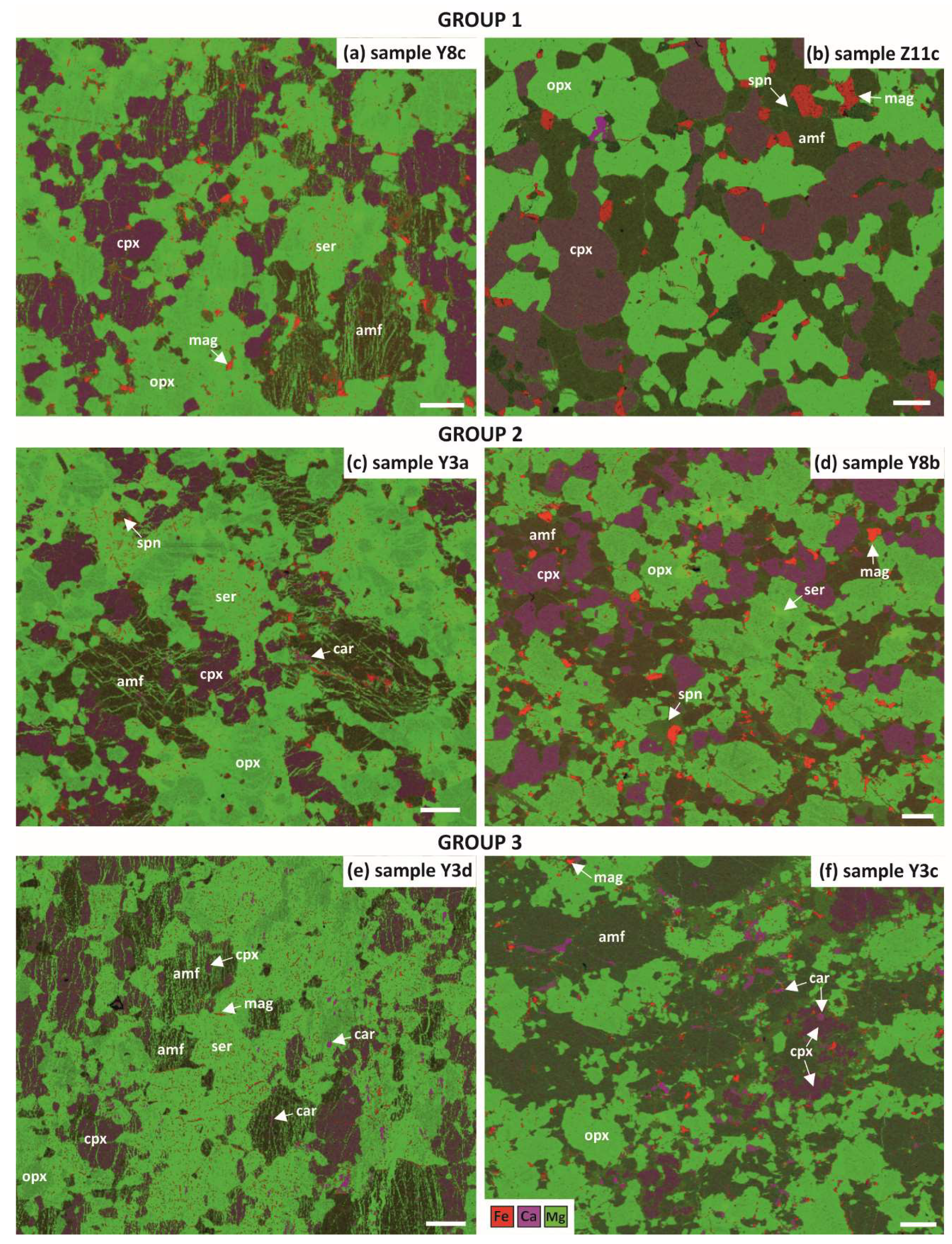
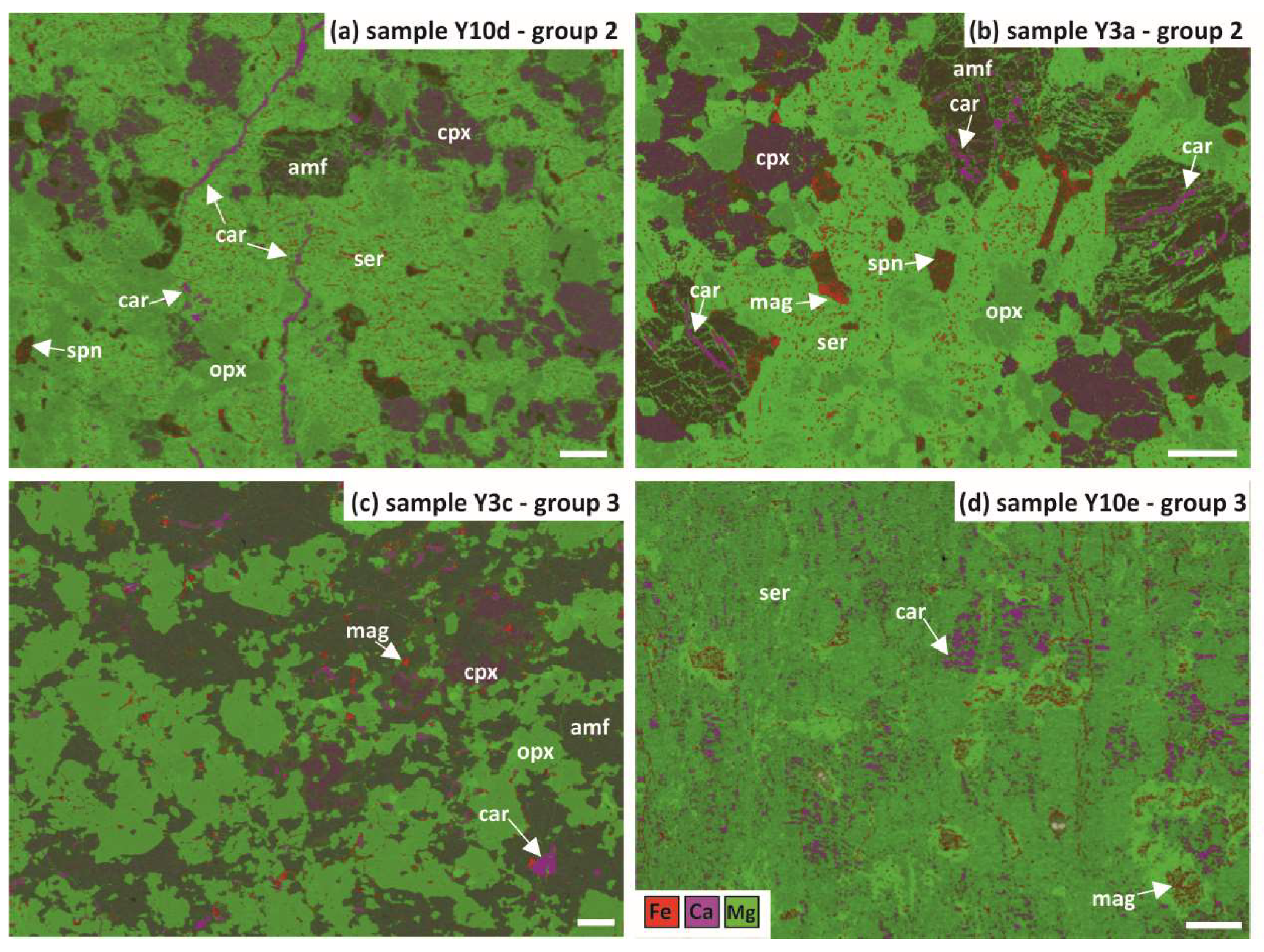
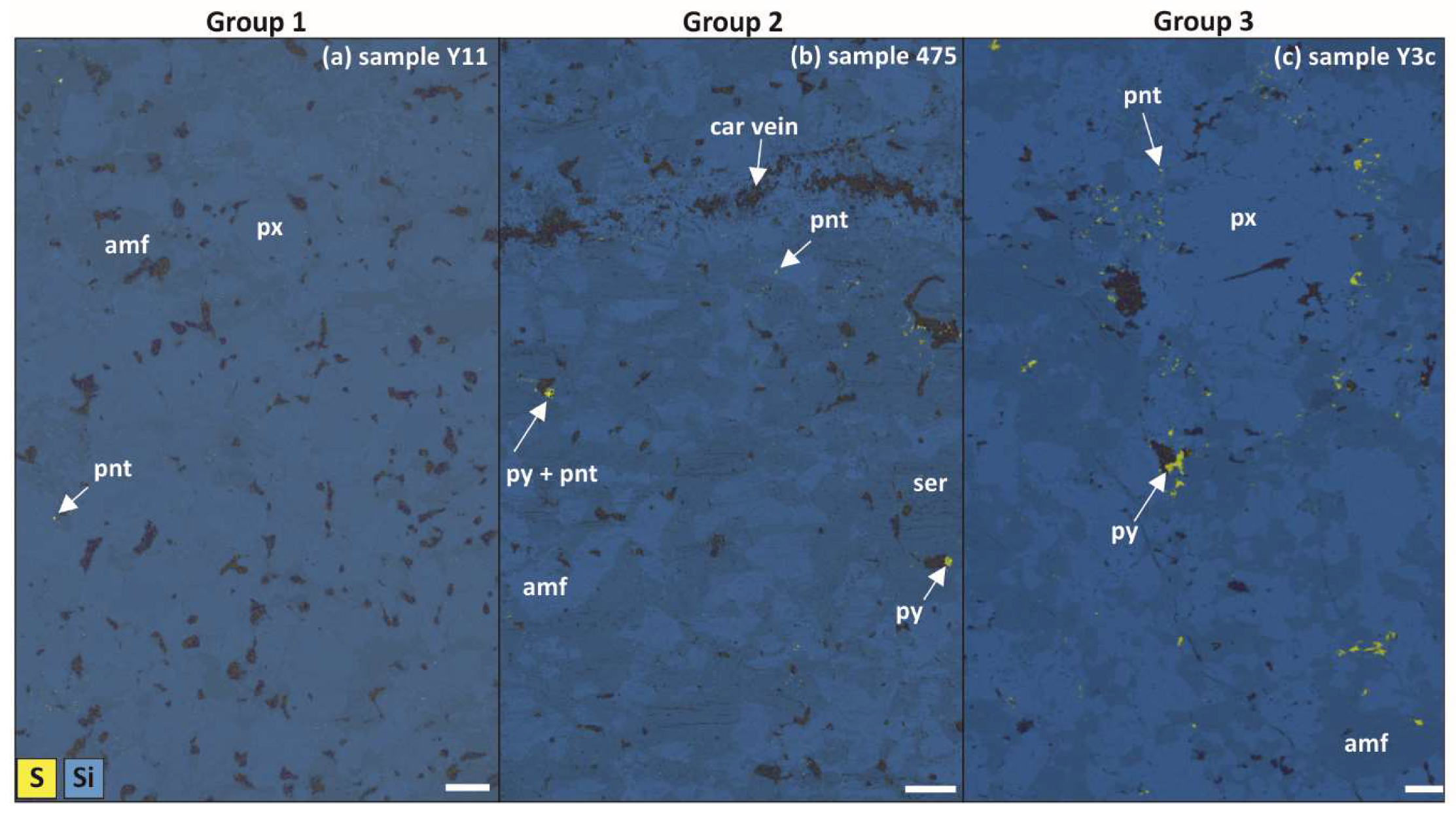

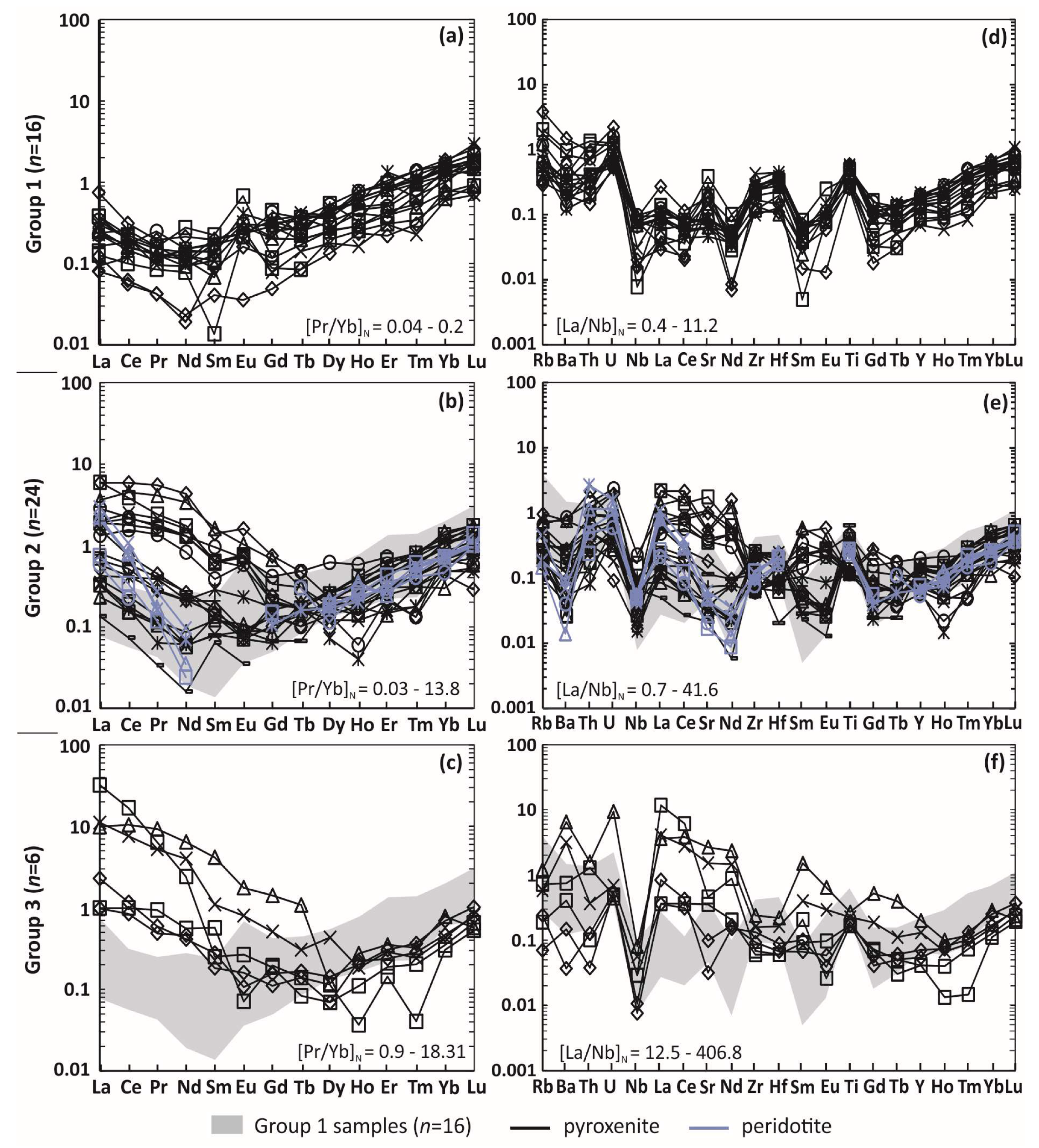
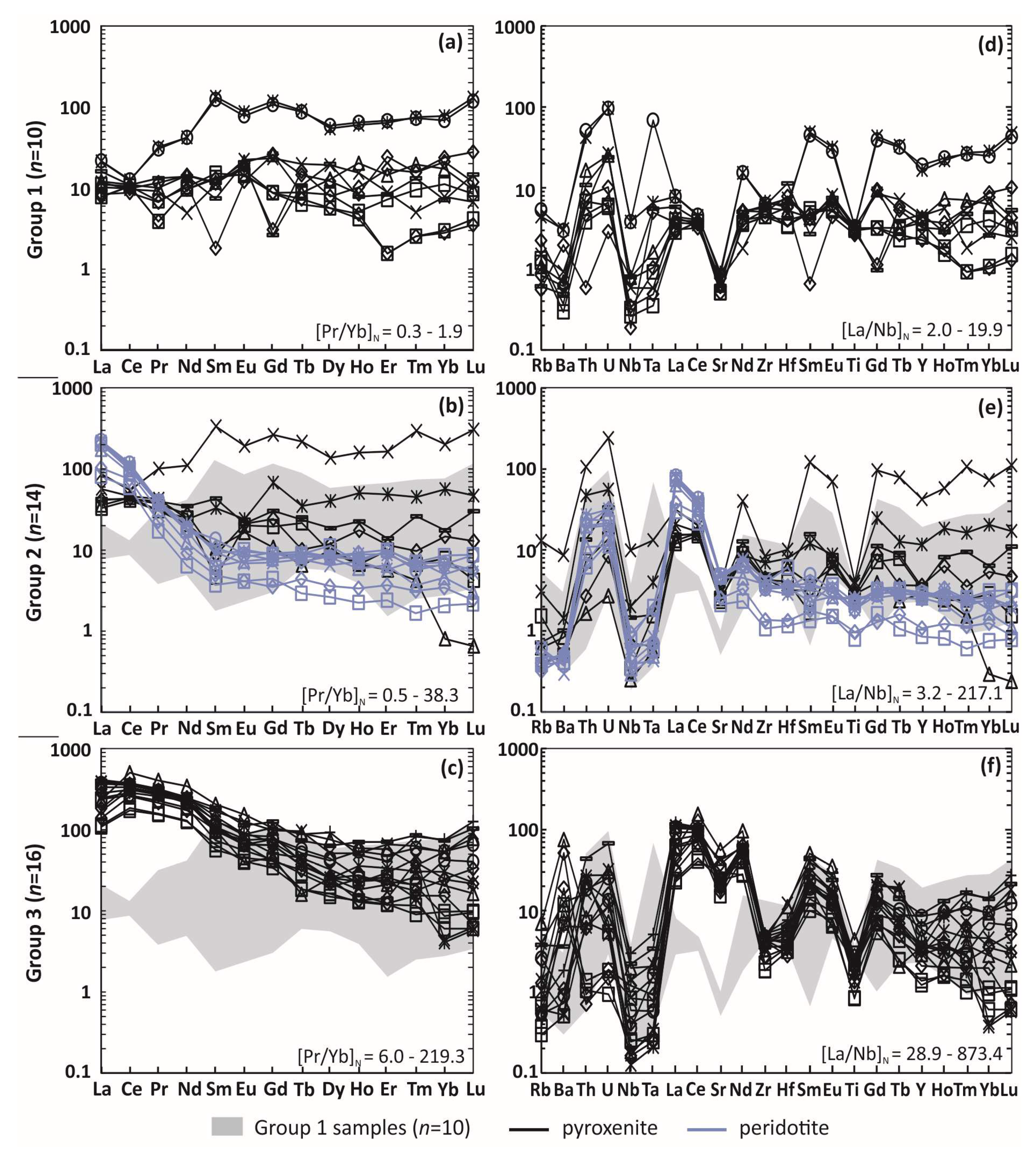
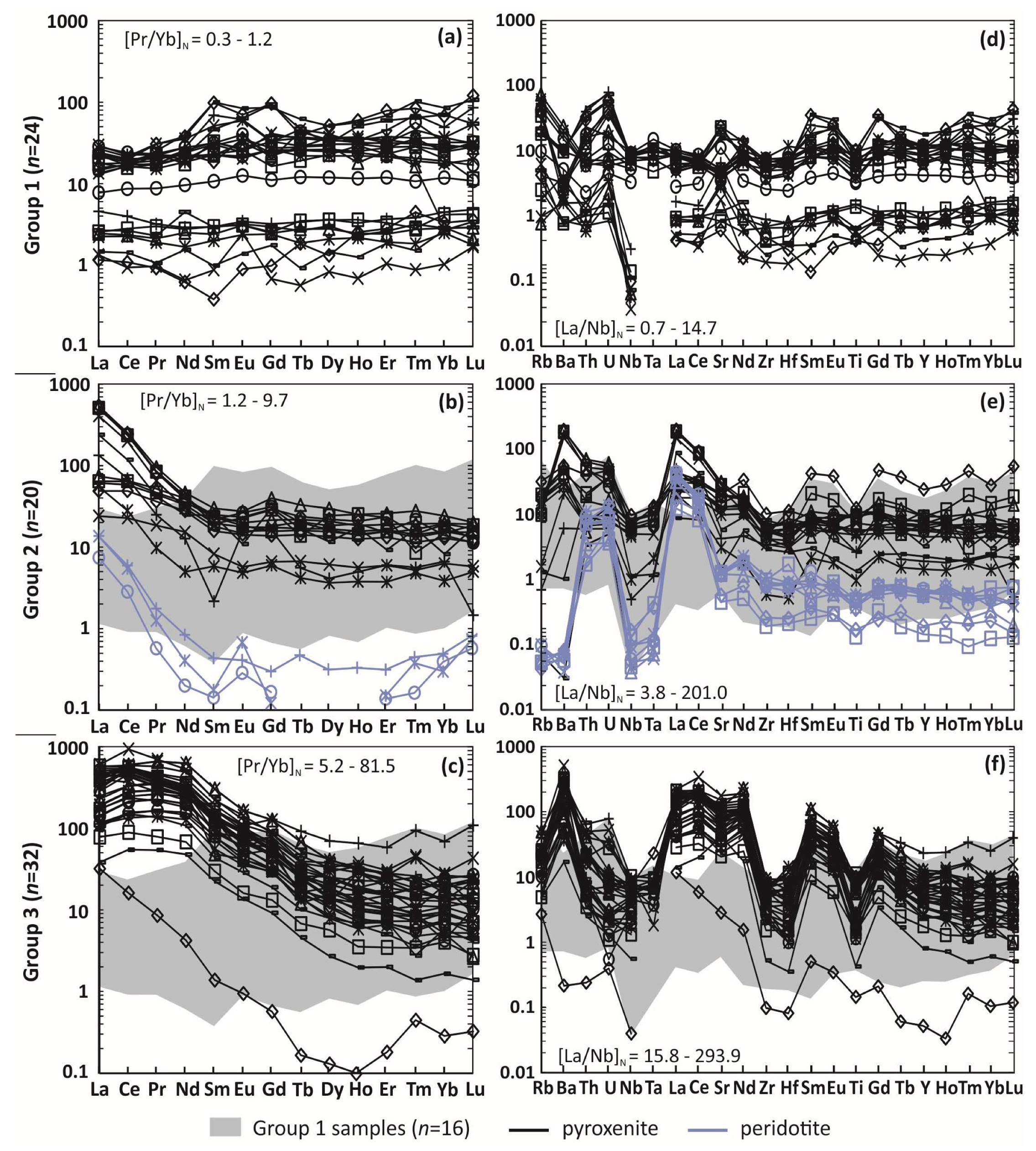
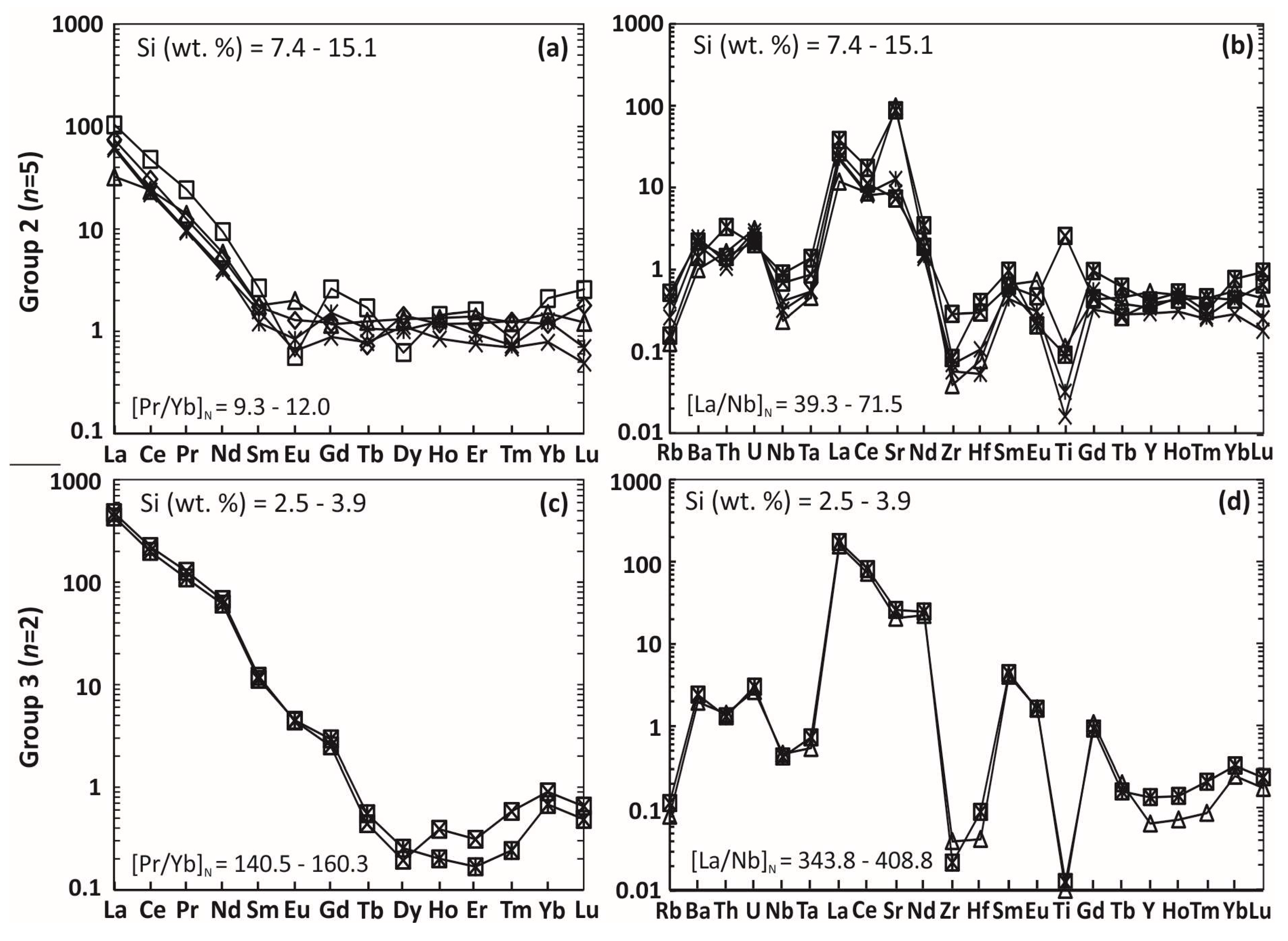
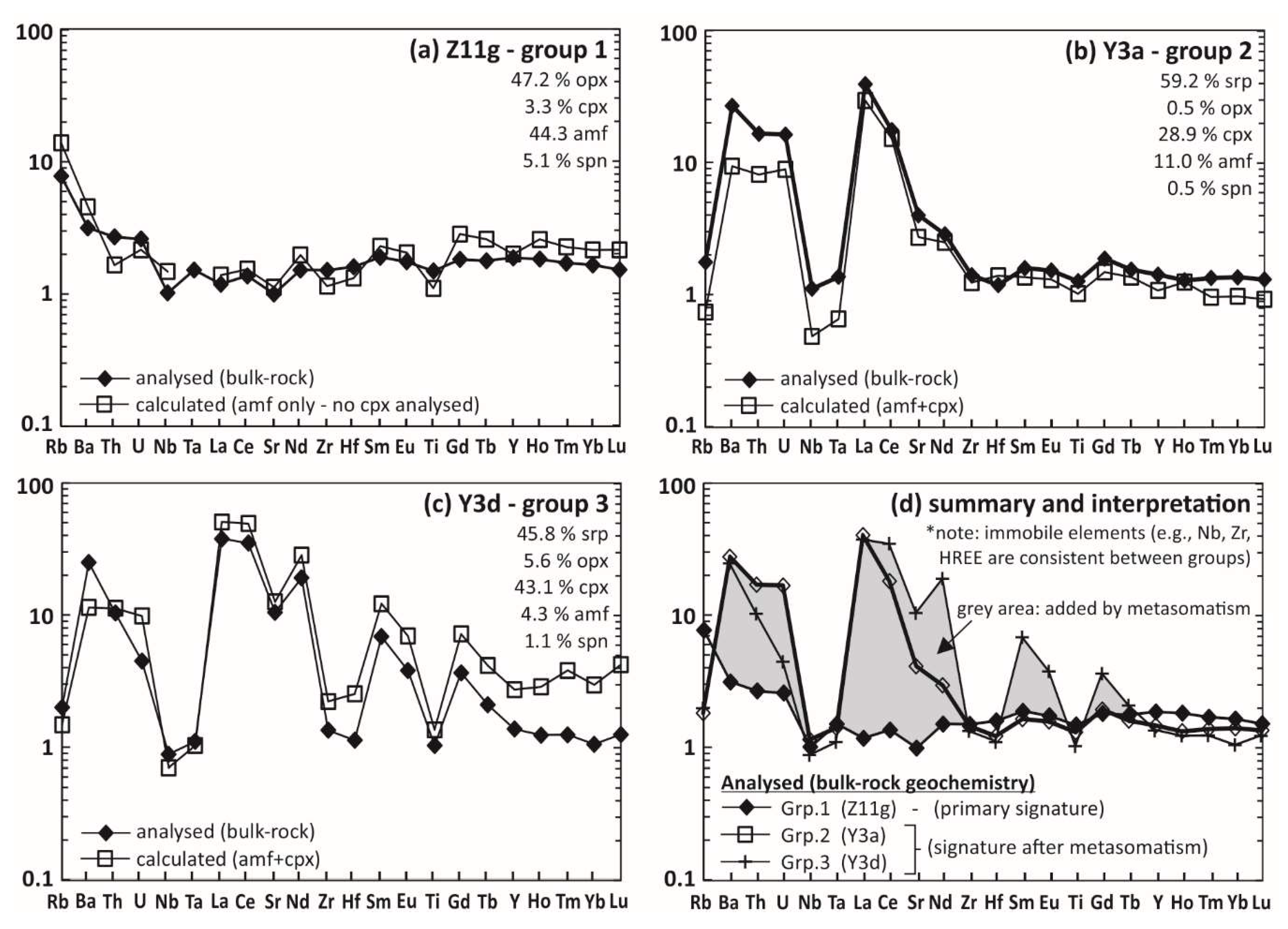
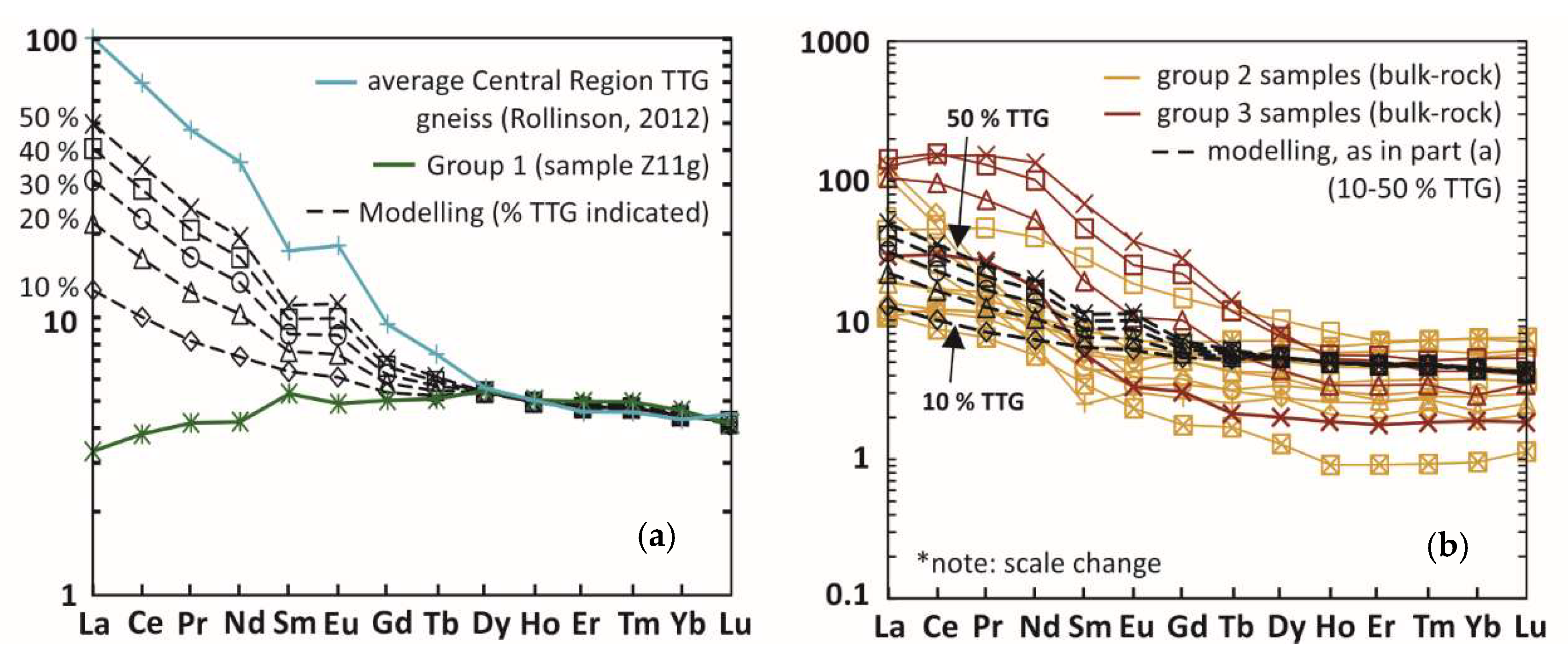
| Thin Section | Grid Reference | Modal Mineralogy (%) | |||||||
|---|---|---|---|---|---|---|---|---|---|
| EM | ol | ser | opx | cpx | amf | spn | carb | ||
| Group 1 samples | |||||||||
| Lw16-Y8a | NC25333/35066 | Y | 0.0 | 0.0 | 58.1 | 23.5 | 16.4 | 2.0 | |
| Lw16-Y8c | NC25333/35066 | Y | 0.9 | 16.5 | 29.0 | 44.8 | 8.2 | 0.7 | |
| Lw16-Y10a | NC25340/35130 | Y | 0.0 | 44.1 | 28.3 | 18.6 | 9.1 | 0.0 | Y |
| Lw16-Y10b | NC25340/35130 | Y | 0.0 | 0.0 | 49.9 | 19.1 | 29.2 | 1.8 | |
| Lw16-Y10c | NC25340/35130 | Y | 5.0 | 2.0 | 57.0 | 12.8 | 22.5 | 0.8 | |
| Lw16-Y11 | NC25328/35174 | Y | 0.0 | 0.0 | 40.3 | 44.9 | 12.3 | 2.6 | |
| Lw16-Y12a | NC25323/35182 | Y | 2.8 | 23.3 | 30.8 | 27.0 | 15.2 | 0.8 | |
| Lw16-Z4a | NC26037/35434 | 0.0 | 0.0 | 46.0 | 3.0 | 48.0 | 3.0 | ||
| Lw16-Z4b | NC26041/35444 | Y | 0.4 | 54.8 | 12.9 | 5.3 | 26.7 | 0.0 | Y |
| Lw16-Z5 | NC26066/35466 | 3.0 | 55.0 | 4.0 | 8.0 | 28.5 | 1.5 | ||
| Lw16-Z11b | NC26072/35569 | 2.0 | 82.0 | 10.0 | 0.0 | 6.0 | 0.0 | ||
| Lw16-Z11c | NC26072/35569 | Y | 0.0 | 0.0 | 42.2 | 25.0 | 28.3 | 4.4 | |
| Lw16-Z11d | NC26072/35569 | Y | 0.0 | 77.0 | 0.0 | 22.3 | 0.0 | 0.8 | |
| Lw16-Z11e | NC26072/35569 | Y | 0.0 | 0.0 | 0.9 | 17.5 | 77.9 | 3.8 | Y |
| Lw16-Z11g | NC26072/35569 | Y | 0.0 | 0.0 | 47.2 | 3.3 | 44.3 | 5.1 | |
| Lw16-Z11h | NC26072/35569 | 0.0 | 0.0 | 58.0 | 10.0 | 28.0 | 4.0 | ||
| Lw16-Z11i | NC26072/35569 | Y | 0.0 | 70.0 | 0.0 | 24.6 | 2.7 | 2.7 | |
| Lw16-510a | NC24879/35120 | Y | 0.0 | 2.7 | 38.2 | 0.0 | 57.8 | 1.4 | |
| Group 2 samples | |||||||||
| Lw16-Y3a | NC25439/34795 | Y | 0.0 | 59.2 | 0.5 | 28.9 | 11.0 | 0.5 | Y |
| Lw16-Y8b | NC25333/35066 | Y | 0.0 | 1.0 | 47.1 | 22.6 | 27.3 | 2.1 | Y |
| Lw16-Y12b | NC25323/35182 | 0.0 | 0.0 | 36.0 | 4.0 | 59.0 | 1.0 | ||
| Lw16-Y13 | NC25345/35234 | Y | 3.9 | 12.7 | 31.4 | 36.9 | 14.6 | 0.4 | Y |
| Lw16-475 | NC26263/35986 | Y | 1.7 | 36.6 | 10.0 | 9.1 | 41.6 | 0.4 | Y |
| Lw16-Y10d | NC25340/35130 | Y | 0.0 | 78.8 | 8.8 | 9.0 | 0.1 | 3.4 | Y |
| Lw16_Z11a | NC26072/35569 | Y | 0.0 | 30.7 | 0.0 | 20.1 | 49.2 | 0.0 | Y |
| LEW007 | NC25375/35591 | Y | 0.7 | 66.5 | 5.3 | 26.5 | 1.0 | 0.0 | Y |
| LEW008 | NC25375/35591 | 0.0 | 0.0 | 91.0 | 0.0 | 9.0 | 0.0 | Y | |
| LEW009 | NC25375/35591 | Y | 3.0 | 51.0 | 4.0 | 35.0 | 5.0 | 0.0 | Y |
| LEW013 | NC25228/35666 | Y | 0.5 | 70.5 | 16.0 | 2.0 | 8.0 | 3.0 | Y |
| Group 3 samples | |||||||||
| Lw16-Y3b | NC25439/34795 | Y | 5.2 | 9.1 | 45.6 | 0.0 | 39.7 | 0.4 | Y |
| Lw16-Y3c | NC25439/34795 | Y | 0.0 | 2.4 | 37.6 | 4.6 | 54.8 | 0.0 | Y |
| Lw16-Y3d | NC25439/34795 | Y | 0.0 | 45.8 | 5.6 | 43.1 | 4.3 | 1.1 | Y |
| Lw16-Y10e | NC25328/35174 | Y | 0.0 | 100.0 | 0.0 | 0.0 | 0.0 | 0.0 | Y |
| Group averages | |||||||||
| Group 1 | n = 18 | 1 | 24 | 31 | 17 | 26 | 2 | ||
| Group 2 | n = 11 | 1 | 37 | 23 | 18 | 21 | 1 | ||
| Group 3 | n = 4 | 1 | 39 | 22 | 12 | 25 | 0 | ||
| Group 1 (n = 20) | Group 2 (n = 11) | Group 3 (n = 4) | ||||||||||
|---|---|---|---|---|---|---|---|---|---|---|---|---|
| Min | Max | Mean | SD * | Min | Max | Mean | SD * | Min | Max | Mean | SD * | |
| Major elements (wt. %) | ||||||||||||
| SiO2 | 35.8 | 44.8 | 41.6 | 2.3 | 41.0 | 48.0 | 43.9 | 2.2 | 39.4 | 47.1 | 44.1 | 2.9 |
| TiO2 | 0.1 | 0.4 | 0.3 | 0.1 | 0.2 | 0.7 | 0.3 | 0.1 | 0.2 | 0.3 | 0.2 | 0.1 |
| Al2O3 | 3.1 | 9.3 | 6.1 | 1.6 | 2.4 | 12.8 | 5.9 | 2.9 | 3.0 | 6.8 | 5.1 | 1.5 |
| Fe2O3 | 9.6 | 13.4 | 11.8 | 1.0 | 8.7 | 13.3 | 11.44 | 1.1 | 9.9 | 11.0 | 10.6 | 0.4 |
| MnO | 0.1 | 0.3 | 0.2 | 0.0 | 0.1 | 0.2 | 0.2 | 0.0 | 0.2 | 0.2 | 0.2 | 0.0 |
| MgO | 27.0 | 47.9 | 33.3 | 5.9 | 17.5 | 42.2 | 31.0 | 6.4 | 27.2 | 43.0 | 32.8 | 6.1 |
| CaO | 0.9 | 11.9 | 6.4 | 2.5 | 0.6 | 9.7 | 6.3 | 2.5 | 4.4 | 7.4 | 5.9 | 1.1 |
| Na2O | 0.1 | 0.9 | 0.4 | 0.2 | 0.03 | 1.8 | 0.6 | 0.5 | 0.1 | 1.1 | 0.6 | 0.4 |
| K2O | 0.01 | 0.1 | 0.06 | 0.0 | 0.01 | 1.35 | 0.2 | 0.4 | 0.01 | 0.4 | 0.2 | 0.2 |
| P2O5 | 0.01 | 0.04 | 0.02 | 0.0 | 0.01 | 0.04 | 0.02 | 0.0 | 0.01 | 0.04 | 0.02 | 0.0 |
| LOI | 0.8 | 9.4 | 3.9 | n/a | 0.7 | 8.2 | 4.6 | n/a | 1.9 | 7.5 | 4.0 | n/a |
| Trace elements (ppm) | ||||||||||||
| Sc | 13.3 | 32.9 | 23.8 | 21.2 | 10.8 | 33.8 | 24.3 | 5.7 | 7.1 | 25.7 | 19.1 | 7.4 |
| V | 82.2 | 201.4 | 126.1 | 36.1 | 36.0 | 165.9 | 101.0 | 39.4 | 56.0 | 116.1 | 91.6 | 39.4 |
| Cr | 1577 | 3475 | 2697 | 446.8 | 1077 | 3165 | 2401 | 596.3 | 1787 | 2612 | 2161 | 344.7 |
| Co | 81.2 | 108.0 | 95.6 | 8.3 | 70.6 | 113.8 | 95.3 | 21.2 | 86.0 | 110.2 | 97.6 | 8.7 |
| Ni | 929 | 2350 | 1419 | 353.5 | 832 | 3236 | 1492 | 596.7 | 1079 | 2357 | 1532 | 515.9 |
| Cu | 3.5 | 445.2 | 67.4 | 93.8 | 4.8 | 118.3 | 42.1 | 31.6 | 4.9 | 393.8 | 133.5 | 157.0 |
| Zn | 56.5 | 1756 | 169 | 364.5 | 31.7 | 165.2 | 69.3 | 43.3 | 73.4 | 97.9 | 83.5 | 9.6 |
| Ga | 3.3 | 7.9 | 6.2 | 1.4 | 3.6 | 14.7 | 6.4 | 3.1 | 3.2 | 8.1 | 5.7 | 1.8 |
| Rb | 0.9 | 51.1 | 2.6 | 1.1 | 0.6 | 141.1 | 16.5 | 39.8 | 0.6 | 5.2 | 2.6 | 1.8 |
| Sr | 13.5 | 84.0 | 42.0 | 21.6 | 13.4 | 245.9 | 80.3 | 58.9 | 60.7 | 568.1 | 343.9 | 216.0 |
| Y | 2.7 | 10.5 | 6.7 | 2.0 | 1.9 | 15.3 | 80.6 | 3.7 | 3.1 | 9.9 | 7.1 | 2.8 |
| Zr | 1.9 | 49.4 | 17.5 | 11.4 | 4.0 | 27.4 | 15.7 | 8.0 | 0.5 | 24.9 | 14.9 | 9.2 |
| Nb | 0.2 | 3.7 | 1.2 | 0.9 | 0.6 | 4.7 | 1.9 | 1.2 | 0.5 | 1.4 | 1.0 | 0.4 |
| Cs | 0.1 | 1.4 | 0.7 | 0.4 | 0.2 | 4.4 | 0.8 | 1.2 | 0.2 | 0.3 | 0.3 | 0.0 |
| Ba | 4.9 | 20.8 | 11.4 | 4.4 | 5.4 | 634.4 | 119.0 | 176.3 | 31.0 | 474.2 | 271.5 | 181.2 |
| La | 0.4 | 1.9 | 0.8 | 0.4 | 2.5 | 30.4 | 9.8 | 6.8 | 6.7 | 33.6 | 23.7 | 10.3 |
| Ce | 0.7 | 3.2 | 2.0 | 0.8 | 5.3 | 35.7 | 15.7 | 8.1 | 18.0 | 95.1 | 18.0 | 31.0 |
| Pr | 0.1 | 0.5 | 0.3 | 0.1 | 0.7 | 4.4 | 1.6 | 0.9 | 2.4 | 14.0 | 8.8 | 4.5 |
| Nd | 0.5 | 2.4 | 1.5 | 0.5 | 2.5 | 18.0 | 5.5 | 4.1 | 7.8 | 61.0 | 34.6 | 20.4 |
| Sm | 0.2 | 0.8 | 0.5 | 0.2 | 0.4 | 4.1 | 1.2 | 1.0 | 0.8 | 10.0 | 5.1 | 3.5 |
| Eu | 0.1 | 0.3 | 0.2 | 0.1 | 0.1 | 1.0 | 0.3 | 0.2 | 0.2 | 2.1 | 1.1 | 0.7 |
| Gd | 0.3 | 1.0 | 0.7 | 0.2 | 0.4 | 2.9 | 1.1 | 0.6 | 0.6 | 5.5 | 3.1 | 1.9 |
| Tb | 0.1 | 0.2 | 0.1 | 0.0 | 0.1 | 0.4 | 0.2 | 0.1 | 0.1 | 0.5 | 0.3 | 0.2 |
| Dy | 0.4 | 1.5 | 1.0 | 0.3 | 0.3 | 2.5 | 1.2 | 0.6 | 0.5 | 2.0 | 1.4 | 0.6 |
| Ho | 0.1 | 0..3 | 0.2 | 0.1 | 0.1 | 0.5 | 0.2 | 0.1 | 0.1 | 0.3 | 0.2 | 0.1 |
| Er | 0.3 | 0.9 | 0.6 | 0.2 | 0.2 | 1.1 | 0.6 | 0.3 | 0.3 | 0.9 | 0.6 | 0.2 |
| Tm | 0.04 | 0.2 | 0.1 | 0.0 | 0.02 | 0.2 | 0.1 | 0.0 | 0.04 | 0.1 | 0.1 | 0.0 |
| Yb | 0.3 | 1.0 | 0.6 | 0.2 | 0.2 | 1.2 | 0.7 | 0.3 | 0.3 | 0.8 | 0.6 | 0.2 |
| Lu | 0.1 | 2.0 | 0.1 | 0.0 | 0.03 | 0.2 | 0.1 | 0.0 | 0.1 | 0.1 | 0.1 | 0.0 |
| Hf | 0.1 | 1.1 | 0.4 | 0.2 | 0.2 | 0.9 | 0.4 | 0.2 | 0.01 | 0.6 | 0.3 | 0.2 |
| Ta | 0.02 | 0.2 | 0.1 | 0.0 | 0.04 | 0.4 | 0.1 | 0.1 | 0.04 | 0.1 | 0.07 | 0.0 |
| Pb | 0.5 | 7.3 | 3.2 | 1.9 | 1.4 | 5.1 | 3.0 | 2.7 | 3.0 | 9.0 | 5.3 | 2.3 |
| Th | 0.1 | 1.2 | 0.3 | 0.3 | 0.2 | 6.3 | 1.2 | 1.7 | 0.2 | 0.8 | 0.6 | 0.2 |
| U | 0.02 | 0.2 | 0.1 | 0.1 | 0.1 | 0.4 | 0.2 | 0.1 | 0.04 | 0.1 | 0.06 | 0.0 |
© 2018 by the authors. Licensee MDPI, Basel, Switzerland. This article is an open access article distributed under the terms and conditions of the Creative Commons Attribution (CC BY) license (http://creativecommons.org/licenses/by/4.0/).
Share and Cite
Guice, G.L.; McDonald, I.; Hughes, H.S.R.; Schlatter, D.M.; Goodenough, K.M.; MacDonald, J.M.; Faithfull, J.W. Assessing the Validity of Negative High Field Strength-Element Anomalies as a Proxy for Archaean Subduction: Evidence from the Ben Strome Complex, NW Scotland. Geosciences 2018, 8, 338. https://doi.org/10.3390/geosciences8090338
Guice GL, McDonald I, Hughes HSR, Schlatter DM, Goodenough KM, MacDonald JM, Faithfull JW. Assessing the Validity of Negative High Field Strength-Element Anomalies as a Proxy for Archaean Subduction: Evidence from the Ben Strome Complex, NW Scotland. Geosciences. 2018; 8(9):338. https://doi.org/10.3390/geosciences8090338
Chicago/Turabian StyleGuice, George L., Iain McDonald, Hannah S. R. Hughes, Denis M. Schlatter, Kathryn M. Goodenough, John M. MacDonald, and John W. Faithfull. 2018. "Assessing the Validity of Negative High Field Strength-Element Anomalies as a Proxy for Archaean Subduction: Evidence from the Ben Strome Complex, NW Scotland" Geosciences 8, no. 9: 338. https://doi.org/10.3390/geosciences8090338
APA StyleGuice, G. L., McDonald, I., Hughes, H. S. R., Schlatter, D. M., Goodenough, K. M., MacDonald, J. M., & Faithfull, J. W. (2018). Assessing the Validity of Negative High Field Strength-Element Anomalies as a Proxy for Archaean Subduction: Evidence from the Ben Strome Complex, NW Scotland. Geosciences, 8(9), 338. https://doi.org/10.3390/geosciences8090338




